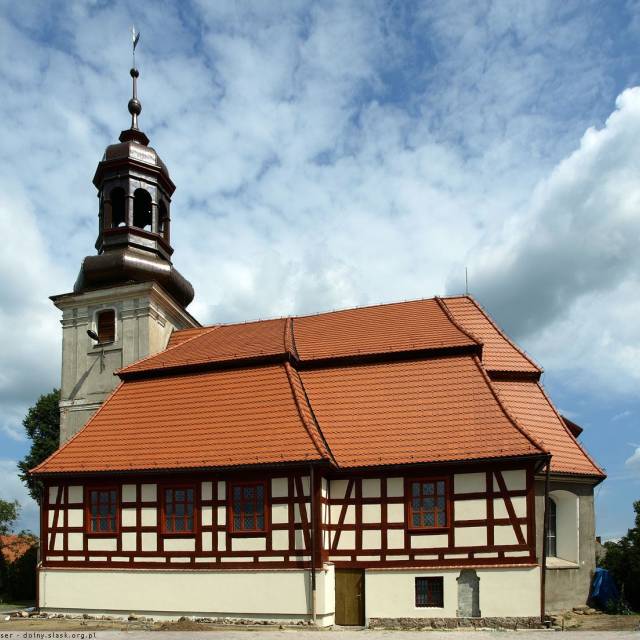The parish church of the Elevation of the Holy Cross, first mentioned in 1346, later in 1353. A new building was erected at the turn of the 15th and 16th centuries. The church was first mentioned in 1346, later in 1353, and at the end of the 15th and beginning of the 16th century a new building was erected (the tower and western portal date from this time). From 1552 the church was used by Protestants. Extended between 1577 and 1590 (nave, chancel). Rebuilt around 1708. (south aisle and north living quarters). Restored between 1973 and 1976. Situated in the central part of the village, Baroque with Gothic (tower) and Renaissance elements. Oriented. Brick and plastered, partly half-timbered (south aisle, north living area). The chancel, the nave, the porch in the ground floor of the tower and the sacristy are covered with a ceiling with facets. The south side aisle has a polychrome wooden beam ceiling. Furnishings and decoration: Baroque altarpiece, 18th century, wooden, architectural, single-storey. In the central part there is a painting of the Crucifixion, baroque, baptismal font, late Gothic, from the turn of the 15th and 16th centuries, sandstone, with rich sculptural decoration consisting of representations in niches closed with arches into a donkey's back on a hexagonal bowl: St. Bishop, St. Hedwig, Mother of God, Archangel, St. Dorothy and three unrecognised saints, on a quadrilateral foot four figures with banners; painting decoration of the chancel from the 18th c, consisting of the Baptism of Christ and the Last Supper on the walls under the galleries, on the ceiling a scene with angels, and three medallions with emblematic representations, on the galleries four medallions with representations of the Evangelists; on the ceiling of the nave a plafond with a scene of the Transfiguration of Christ from the early 18th century; polychrome ceiling of the south nave, baroque, from 1708, with patronal decoration with floral motifs. On the south elevation of the chancel, a partially destroyed inscribed epitaph from 1713.
The church is surrounded by a stone wall about 1.5 m high. In its southern part there is a gate, baroque, from the second half of the 18th century, brick, plastered, triaxial.
From 1550 to 1945 the church was under the patronage of the City of Wrocław - the church seal showed the municipal coat of arms of Wrocław.
Source: dolny-slask.org.pl





















